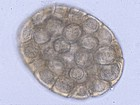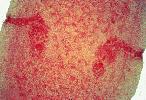Difference between revisions of "Dipylidium caninum"
| Line 46: | Line 46: | ||
The eggs are 25-50μm in length. | The eggs are 25-50μm in length. | ||
| − | + | ==Life-Cycle== | |
| − | The egg packets are | + | The oncospheres are within the egg packets. These are ingested by the intermediate host. They develop into cysticercoids, which is infective by the time that metamorphosis is complete. |
| + | |||
| + | Complete development in the intermediate hosts lasts around 1 month. The final host is infected via ingestion of the flea or louse, containing the cysticercoid. | ||
[[Category:Cyclophyllidea]] | [[Category:Cyclophyllidea]] | ||
[[Category:To_Do_-_Max]] | [[Category:To_Do_-_Max]] | ||
Revision as of 20:10, 16 July 2010
| This article is still under construction. |
Dipylidium caninum
| Also known as: | Double-pored tapeworm
|
Introduction
D. caninum is a very commonly seen parasite of dogs and cats, growing to 50cm long in the small intestine. It is of minor clinical significance, causing no more than occasional anal irritation. Diarrhoea may result if the tapeworms are present in large numbers. The proglottids are motile and can upset owners when they drop onto the furniture or floor.
Scientific Classification
| Kingdom | Animalia |
| Phylum | Platyhelminthes |
| Class | Cestoda |
| Order | Cyclophyllidea |
| Family | Dipylidiidae |
| Genus | Dipylidium |
| Species | D. caninum |
Identification
D. caninum resemble Taenia spp, but are considerably shorter than Taenia. D. caninum have a scolex and a proglottid, which are easily recognized in this species. This parasite also has two sets of genital organs.
The eggs are 25-50μm in length.
Life-Cycle
The oncospheres are within the egg packets. These are ingested by the intermediate host. They develop into cysticercoids, which is infective by the time that metamorphosis is complete.
Complete development in the intermediate hosts lasts around 1 month. The final host is infected via ingestion of the flea or louse, containing the cysticercoid.

